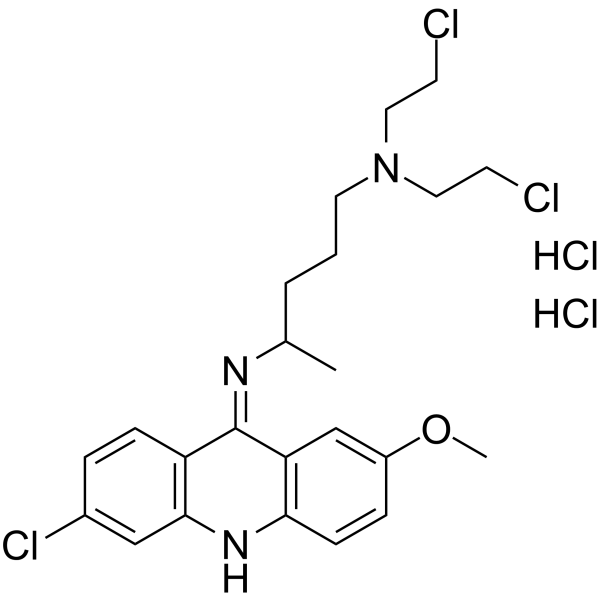Quinacrine mustard dihydrochloride

Quinacrine mustard dihydrochloride structure
|
Common Name | Quinacrine mustard dihydrochloride | ||
|---|---|---|---|---|
| CAS Number | 4213-45-0 | Molecular Weight | 541.76900 | |
| Density | 1.271g/cm3 | Boiling Point | 574.1ºC at 760 mmHg | |
| Molecular Formula | C23H30Cl5N3O | Melting Point | 150 °C | |
| MSDS | Chinese USA | Flash Point | 301ºC | |
| Symbol |


GHS06, GHS08 |
Signal Word | Danger | |
Use of Quinacrine mustard dihydrochlorideQuinacrine mustard dihydrochloride is a fluorochrome. Quinacrine mustard dihydrochloride as a polycyclic aromatic agent can be used as mutagenic agent induces the mutants of bacteria. Quinacrine mustard dihydrochloride induces cell cycle arrest at G2/M-phase. Quinacrine mustard dihydrochloride has the potential for the research of plant, animal, or human chromosomes[1][2][3]. |
| Name | quinacrine mustard dihydrochloride |
|---|---|
| Synonym | More Synonyms |
| Description | Quinacrine mustard dihydrochloride is a fluorochrome. Quinacrine mustard dihydrochloride as a polycyclic aromatic agent can be used as mutagenic agent induces the mutants of bacteria. Quinacrine mustard dihydrochloride induces cell cycle arrest at G2/M-phase. Quinacrine mustard dihydrochloride has the potential for the research of plant, animal, or human chromosomes[1][2][3]. |
|---|---|
| Related Catalog | |
| In Vitro | Quinacrine mustard dihydrochloride (5 µg/ml) can be used for the DNA strain of plant, animal, or human chromosomes[1]. Quinacrine mustard dihydrochloride (28 µM) increases the number ofmutants that appeared after an exposure of bacteria[2]. quinacrine mustard dihydrochloride (0.2 µM; 4h) induces cell cycle arrest at G2+M-phase in HL-60 cells[3]. Caffeine (5 mM) prevents the cytotoxic action of quinacrine mustard dihydrochloride (0.2 µM; 4h) in HL-60 cells[3]. Cell Cycle Analysis[3] Cell Line: HL-60 cells Concentration: 0.2 µM Incubation Time: 4 h Result: Induced cell cycle arrest at G2+M-phase with the accumulation of cells in this compartment by 50%. |
| References |
| Density | 1.271g/cm3 |
|---|---|
| Boiling Point | 574.1ºC at 760 mmHg |
| Melting Point | 150 °C |
| Molecular Formula | C23H30Cl5N3O |
| Molecular Weight | 541.76900 |
| Flash Point | 301ºC |
| Exact Mass | 539.08300 |
| PSA | 37.39000 |
| LogP | 8.08720 |
| Index of Refraction | 1.632 |
CHEMICAL IDENTIFICATION
HEALTH HAZARD DATAACUTE TOXICITY DATA
MUTATION DATA
|
| Symbol |


GHS06, GHS08 |
|---|---|
| Signal Word | Danger |
| Hazard Statements | H301-H317-H331-H334-H361 |
| Precautionary Statements | P261-P280-P301 + P310-P311 |
| Personal Protective Equipment | Eyeshields;Faceshields;full-face particle respirator type N100 (US);Gloves;respirator cartridge type N100 (US);type P1 (EN143) respirator filter;type P3 (EN 143) respirator cartridges |
| Hazard Codes | T+ |
| Risk Phrases | 46-23/25-42/43 |
| RIDADR | UN 3249 |
| RTECS | AR7580000 |
| Packaging Group | III |
| Hazard Class | 6.1(b) |
|
Inhibition of heparin-induced tau filament formation by phenothiazines, polyphenols, and porphyrins.
J. Biol. Chem. 280(9) , 7614-23, (2005) Tau protein is the major component of the intraneuronal filamentous inclusions that constitute defining neuropathological characteristics of Alzheimer's disease and other tauopathies. The discovery of... |
|
|
Molecular cytogenetic analysis of the highly repetitive DNA in the genome of Apodemus argenteus, with comments on the phylogenetic relationships in the genus Apodemus.
Cytogenet. Cell Genet. 92(3-4) , 254-63, (2001) The DNA of Apodemus argenteus was digested with DraI, and the resultant DraI fragment of highly repetitive DNA was isolated and analyzed by DNA filter hybridization, cloning, sequencing, and fluoresce... |
|
|
Separation of sperm through a 12-layer percoll column decreases the percentage of sperm staining with quinacrine.
Arch. Androl. 44(1) , 47-50, (2000) Previous methods of enriching sperm with a higher percentage of Y-bearing sperm have been questioned because the claims that Y enrichment was present were based on quinacrine staining of the Y chromos... |
| Quinacrine mustard dihydrochloride |
| N4,N4-Bis-(2-chlor-aethyl)-N1-(6-chlor-2-methoxy-acridin-9-yl)-1-methyl-butandiyldiamin,Dihydrochlorid |
| N1,N1-bis(2-chloroethyl)-N4-(6-chloro-2-methoxyacridin-9-yl)pentane-1,4-diamine dihydrochloride |
| EINECS 224-140-9 |
| N4,N4-bis-(2-chloro-ethyl)-N1-(6-chloro-2-methoxy-acridin-9-yl)-1-methyl-butanediyldiamine,dihydrochloride |
| quinacrine mustard |
| Atabrine mustard dihydrochloride |
| ICR 10 |
| 3-chloro-7-methoxy-9-(1-methyl-4-(N,N-bis(2-chloroethyl)amino)butylamino)acridine dihydrochloride |
| 1-N,1-N-bis(2-chloroethyl)-4-N-(6-chloro-2-methoxyacridin-9-yl)pentane-1,4-diamine,dihydrochloride |
| Mepacrine mustard dihydrochloride |

